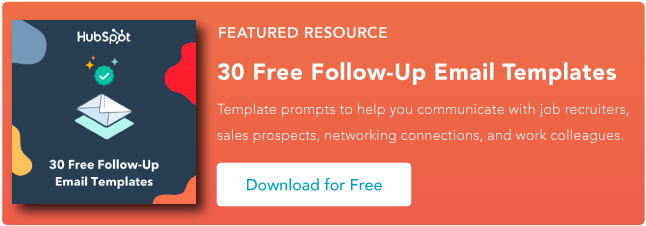The first point of contact is important, of course. You never get a second chance to make a first impression. But many salespeople and marketers make the mistake of crafting a perfect sales email, holding a great meeting, or running a fantastic product demo, and then sitting back and doing nothing.
If you’re guilty of this, you might need to perfect your sales follow-ups. Read on to learn how to do this, and why it matters.
Mastering your sales follow-up is a critical skill for reps however, many are not following up enough.
According to a study by Brevet, 80% of sales require an average of five follow-ups in order to close the deal. However, 44% of sales reps follow up with a prospect only once before giving up. After four follow-ups, 94% of salespeople have given up.
That’s an awful lot of potential sales that are never being closed, and potential revenue that is being left on the table.
Reticence over following up is understandable. Salespeople are very aware that their profession can carry a reputation for being pushy or aggressive. You don’t want to be seen as annoying or not taking the hint, so you simply stop following up.
However, do you know the number one reason why a prospect won’t get back to you? It’s not because they are not interested, it’s because they are busy. Decision makers have a lot of conflicting priorities to juggle and many different demands on their time. According to Harvard Business Review, professionals have on average over 200 emails in their inbox at any one time.
In other words, they’re (probably) not ignoring you because they don’t want what you have to offer. You just need to be tenacious to get their attention because they have a lot going on. In the next section, we’ll learn how to perfect the art of the follow-up.
Sales Follow-Up Techniques
1. Use a variety of follow-up methods.
So you’ve sent two or three follow-up emails to your prospect and heard nothing back. It may be time to pick up the phone. Alternatively, if you keep calling and they’re always too busy to speak to you, you might have more luck by sending an email instead.
Don’t stop at just telephone and email, either. Obviously I’m not suggesting you track someone down on every platform you can think of, but if you’re connected on a professional platform such as LinkedIn, there’s no reason you can’t use that to follow up.
In short, if you’re not sure what someone prefers, try different follow-up methods. People prefer different methods of communication, and what gets one person’s attention will go ignored by another.
On the other hand, if someone specifies a particular method of communication, respect that. You won’t endear yourself to a prospect if you keep calling them after they’ve said they like to do all business by email.
2. Space it out.
The quickest way to annoy your prospect and put them off is not following up too many times — it’s spacing your follow-ups too closely together.
Purchasing decisions often move slowly, and even more so when the product or service is of a substantial value. Therefore, you probably cannot expect prospects to make a decision instantly, or even overnight.
At my web design agency, clients typically spend thousands of dollars with us on a project. This is a major purchasing decision and cannot be rushed. Therefore, we need to be aware of longer lead times when we follow up. For those who sell B2B, there are often multiple stakeholders involved in the decision making process.
There’s no exact formula for correctly spacing your follow-ups. In most circumstances, every day will be far too often, and once a month is not often enough. I find that once per week or so is appropriate in most circumstances.
The best thing you can do in terms of spacing out your follow-ups is to understand your prospect’s timeframe. For example, let’s imagine you’ve hosted a product demo to introduce a prospect to your software solution. They say they will raise it with the Board at next week’s meeting. In this situation, following up with them the next day will only annoy them.
Here’s an extra tip for you: Take the guesswork out of follow-up timing with HubSpot's free email tracking software, which notifies you instantly when prospects engage with your emails. You can set reminders for yourself on your calendar to ensure you never miss the opportunity to follow up at the right time.
3. Provide value with each follow-up.
Even though you are a salesperson, your prospects don’t want to feel as though they are on the receiving end of an aggressive sales pitch. Hard selling simply does not work any more. Instead, you can get better results by engaging the prospect with each follow-up and ensuring you provide them with value.
In other words, it’s not about you or even about your product. It’s about them.
Here are some ways to provide value with your follow-ups:
- Begin by asking the prospect how they are and how business is going — Ideally, you should strive to remember something significant about each prospect. For example, let’s imagine your prospect told you that they were about to bring a new product to market. The next time you speak with them, you should ask how it went. Simply remembering things about people and showing that you care helps to build the kind of human connection that drives sales.
- Keep notes about the prospect’s pain points and the problems they are trying to solve — Always center the conversation on these pain points and problems. Remember: you’re not just selling a product. You’re selling a solution to a problem.
- Include a link to a relevant article, blog post, or video in your follow-up email — The content must relate strongly to the prospect and the problems they’ve told you they are facing. By providing them with useful content, you prove that you are interested in a mutually beneficial relationship as opposed to a quick sale.
- Notify them of a special offer or limited-time discount — This can be a great way to re-engage with a prospect you haven’t talked to in awhile.
Remember that “value” does not have to be financial. You simply need to ensure that you are offering something useful to the person every time you speak to them.
4. Always define the next steps.
One of the biggest follow-up mistakes salespeople make? Not clearly defining the next steps in the process with the prospect.
For example, if the prospect says they need time to discuss your offer with their team, agree to follow up with them a week or two later. If you’ve held a successful product demo and they have expressed interest, arrange another call soon to move things along.
Be as specific as possible. “I’ll call you next week” is vague. “I’ll call you on Wednesday — how’s 9:30 for you?” is much better.
5. Subject lines matter.
If you’re following up by email, the subject line can make or break the success of your follow-up. As we’ve previously discussed, senior executives and decision makers have hundreds, if not thousands, of emails in their inbox at any one time. Therefore, you need to grab their attention enough to make them want to open your email in the first place.
A generic subject line like “Just checking in” or “follow up” won’t cut it. These are easy to ignore or send straight to the trash folder. Instead, you’ll need to craft something enticing that will make them want to know what you have to say.
Perhaps the most important thing to do is personalize your subject line by using the recipient’s name. One study showed that this increased open rates by around 29%:
Here are some other follow-up subject line best practices to be aware of:
- Keep it short, to-the-point, and conversational in tone.
- Create a sense of urgency. This might include referencing a specific time (e.g., “meeting on Wednesday at 10 am?”), or a limited-time offer (“We’d love to offer you 20% off this week only!”)
- Ask a direct question. A question like “can you help me out?” or “what do you think about…” can entice the recipient to open the email and respond.
- Make it clear the email contains valuable content. A subject line like, “saw this video and thought of you” or “thought this article might be useful to you” demonstrates value.
Remember that your first hurdle is to get them to open your email, so take the time to craft an irresistible subject line.
6. Keep it brief.
As we’ve discussed, your prospects are busy people. They do not have time for rambling emails, long phone calls, or endless meetings. Instead, cut to the chase and keep your follow-ups brief and to the point.
An email follow up should be no more than about six lines in total length. And a follow-up telephone call should generally last no longer than around ten minutes.
Doesn’t sound very long? That’s because it isn’t. You have only a short timeframe to grab your prospect’s attention and make them want to take action, so be direct.
7. Know when to stop.
You can’t keep following up forever. At a certain point, it becomes aggressive, pushy, or just pointless.
When is enough enough? It’s hard to say, because it depends on the circumstances. Some marketers recommend following up endlessly until you receive a definitive response. I do not subscribe to this model, personally.
Since 80% of successful sales require five follow-ups on average, I recommend using this as your baseline. Certainly send no more than six or seven in total. At a certain point, a lack of response is a no.
I recommend sending one final email before you stop contacting the prospect. This is known as the break-up email. If the prospect was interested but hadn’t got around to replying to you, this will spur them into action. If not, you have closed out the pitch and they know not to expect to hear from you again. Check out this post for sample break-up templates.
It goes without saying that you should stop following up immediately if the prospect comes back with a firm “no” or otherwise indicates a clear lack of interest. Continuing to contact them at that point is simply spamming.
Don’t Be Afraid of Follow-ups
Many salespeople are afraid of the follow-up stage of the sales process. This is because they fear annoying the prospect, being seen as a spammer, or even losing a potential sale due to following up too much.
You might even be afraid to follow up in case you hear a definite “no.” But here’s something you should understand: a clear “no” is a gift. It means you can cross that prospect off your list, stop wasting time, and move on to someone who is interested in what you’re offering.
However, failing to follow up is one of the quickest ways to lose up to 80% of your potential sales. That’s an awful lot of revenue you’re not making. Therefore, stop being afraid of the follow-up. It is a crucial part of doing business.
I recommend reframing it in your mind. You’re not following up with the prospect to spam them, annoy them, or pressure them into making a purchase. Instead, you’re being persistent because you have a product or solution that can help them fulfill a need.
If you start to see following up as part of building a relationship with a prospective client, you’ll come to understand its importance and stop being afraid of it. Good luck!
.png?width=112&height=112&name=Image%20Hackathon%20%E2%80%93%20Square%20(50).png)
.jpg)

.png)










